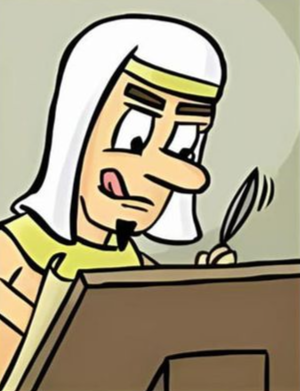Post this shit on LinkedIn and watch them lap it up
Bossware of ancient times.
I learned a word today.
The whipping continues until moral improves
moral improves
Not sure if that was intentional, but I suppose it’s technically correct.
What does he think is above his head in the third panel?
The Dendera Light, obviously.
I see Milo, I upvote
“Please tell me this links to Miniminuteman”
Awwe yiss. Great channel
https://en.wikipedia.org/wiki/Great_Pyramid_of_Giza
The Great Pyramid of Giza[a] is the largest Egyptian pyramid. It served as the tomb of pharaoh Khufu, who ruled during the Fourth Dynasty of the Old Kingdom. Built c. 2600 BC,[3] over a period of about 27 years,[4] the pyramid is the oldest of the Seven Wonders of the Ancient World, and the only wonder that has remained largely intact.
https://en.wikipedia.org/wiki/Ancient_Egyptian_technology
The wheel
Evidence indicates that Egyptians made use of potter’s wheels in the manufacturing of pottery from as early as the 4th Dynasty (c. 2613 to 2494 BC).[98] Lathes are known from at least 1300 BC,[99] but Flinders Petrie claimed that they had been used as early as the 4th Dynasty, based on tool marks found on stone bowls from that period.
I don’t know if they used it for transport then, but they had the wheel at about that point in time.
It could be that comic strips are not the best place to learn about ancient history.
Surprised Pikachu face dot jpg
I mean, you say that, but whenever they get posted to Lemmy, there’s always someone in the comments sharing the facts. 🙃
I like that though
Yeah, me too.
Wheels and sand don’t mix well together, so I guess it’s unlikely they used wheels for transportation.
The wheel (for transportation) is really a concomitant of stable roads existing. Really wheels only work on flat, paved surfaces. The “invention” of the wheel isn’t the stroke of genius that pop culture likes to portray it as. It’s just something that follows from having the right environment. The Romans for instance built and maintained widespread road networks throughout Europe to quickly move troops to the front lines. It turns out that those roads also were a tremendous boon for traders and travellers using carts.
Comic’s still funny though.
The theory I learnt in school was that they placed the bricks on a row of tree trunks that served as “wheels” or rather, a type of conveyor belt.
The trunk that was freed at the back by pulling the brick forward was placed in front again. Not sure if that’s still the current theory.They did not need it for transport. They had camels. Much more useful in a sandy desert.
Camels were not introduced to Egypt until the Persians invaded in 525 BCE.
They dragged things on sledges with someone wetting the sand in front of them.
We have no doubt about that.

Actually almost all of the people in ancient Egypt lived in the Nile river delta, because of the fertile soil. As such they mostly used boats to transport things up and down the river. They also used a lot of ships for trading with other lands along the Mediterranean coast. For smaller local transport carts were used, as they didn’t live in a desert environment, but instead in a lush agricultural land.
furtive soil
Well that explains the desertification I guess.
Oops autocorrect, fixed
*autocorrupt
**autocarrot
Yea because wheels suck on sand.
Super random question. Does anyone know what it’s called when you stick your tongue out like that when concentrating? It seems so prevalent n cartoons or comics

So after falling into a bit of a rabbit hole, I still don’t know what it’s called, but apparently it’s believed to be an involuntary trigger to shut off communication to preserve brain power for other cognitive functions.
Worst part is, given the lack of leverage, that whip might cause less damage, and possibly even do what the driver thinks it will; speed up the enslaved people. But it won’t be for the reasons the slaver expected it to.
Sigh…
AI, that you?












